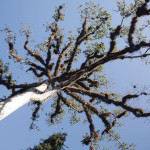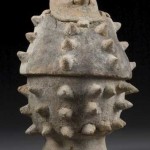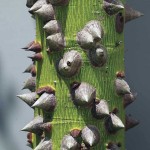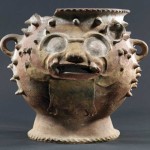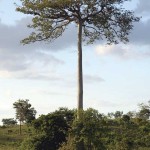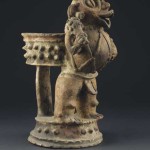Ceiba pentandra
Sacred tree for Classic Maya, national tree for Guatemala today
by Dr. Nicholas M. Hellmuth
Look at the sacred ceiba tree and you may notice that its spines resemble the round bumps that the Maya incorporated on their incense burners, cache vessels and urns.
Notice the pattern of conical, spine-like protuberances on these thousand-year-old ceramic vessels. You get the same kinds of spine-like bumps on Early Classic Petén pottery as well as Late Classic Highland Quiché vessels.
The spines on the pottery vessels look about the same size and shape as spines on a common tree in Guatemala. This is Ceiba pentandra, which has been sacred for over 2,000 years. The immense size, fast growth, gorgeous flowers and the animals associated with this tree are all reasons it was of interest to the Maya people, priests and rulers.
As a result, the characteristic conical spines on the trunk of a young ceiba tree decorate Mayan incense burners and burial urns. Considering that a mature ceiba can live several centuries and will grow to be one of the largest trees in the tropical world, it is no wonder that the tree “house” of the innovative 3D movie “Avatar” may have been partially modeled after some aspects of a ceiba-like tree.
What distinguishes Ceiba pentandra from other species are the pattern and size of its conical spines. Botanists call these prickles, but to me they are spines (they are not long and thin, nor short, so I don’t call them thorns). But they sure are sharp.
If you look at a dozen trees of the same species each tree may have a different size and quantity of spines. Some trees may be totally covered with spines. Other trees may have only a few random spines. And most mature ceiba trees may not have any spines at all.
Ceiba-like trees can be found all around the world, including Africa. I can remember seeing several around my hotel in that part of the world. Everything about the tree was almost identical to the ceiba I enjoy in Guatemala. Although the Old World ceiba was slightly distinctive, I find it remarkable that on two sides of the ocean the trees species would be so remarkably similar.
To see ceiba trees in Guatemala, visit Auto Safari Chapín on the highway to Taxisco, Escuintla. Tikal National Park has a huge ceiba tree as you walk from the entrance area (museum) out to the fork in the road into the ruins. There is a giant ceiba tree at the right.
The ruins of Ceibal, near Sayaxché, Petén, are named after ceiba trees. (Seibal in English; but more properly Ceibal in Spanish.) There are dozens of ceiba trees out in the cattle pastures on the highways going up to Petén and down to the south coast. Some may be different species, but their impressive size and form of the branches will identify them as a member of the ceiba family.
To see Mayan pottery with ceiba spines, visit the two museums at the Hotel Casa Santo Domingo in La Antigua. These museums include ancient art that depicts sacred plants and animals. You can also find examples from Fundación La Ruta Maya in various museums in Antigua and Guatemala City. Plus, be sure to experience the Museo Popol Vuh, Universidad Francisco Marroquin. The Museo Nacional de Arqueología also has ceramic art with ceiba tree spines.
Now, when you stand in front of a 4th-10th century Mayan urn, cache vessel or incense burner and see the conical shapes sticking out, you’ll know that these mimic the spines of a ceiba tree: The vessel is intended to represent the trunk, the base, of this sacred tree. The trunk of a tree was usually its personification.
We at FLAAR hope that this introductory discussion of the ceiba tree spines has allowed you to better recognize features in ancient Mayan art. Plus, the next time you see a ceiba tree in Guatemala you will realize that, in addition to being the national tree today, it was the sacred tree for thousands of years before that.
photos Nicholas Hellmuth, courtesy of Flaar Archive
Dr. Nicholas Hellmuth is director of FLAAR Reports (Foundation for Latin American Anthropological Research). For more information visit www.digital-photography.org
